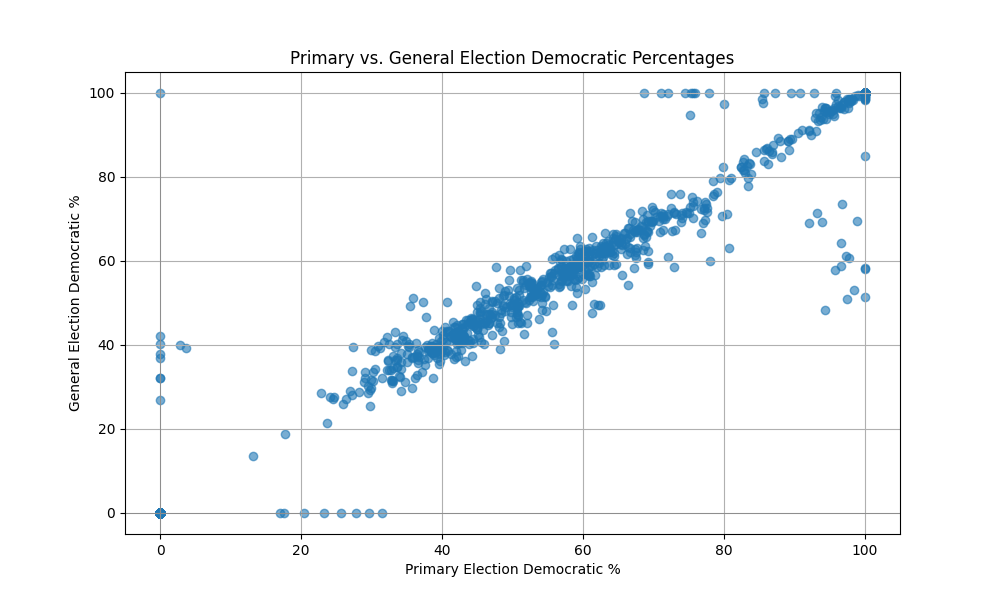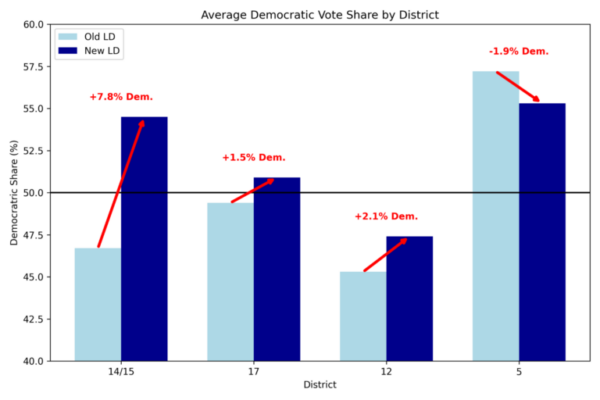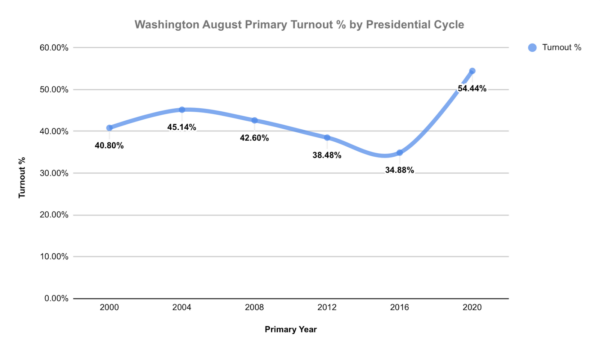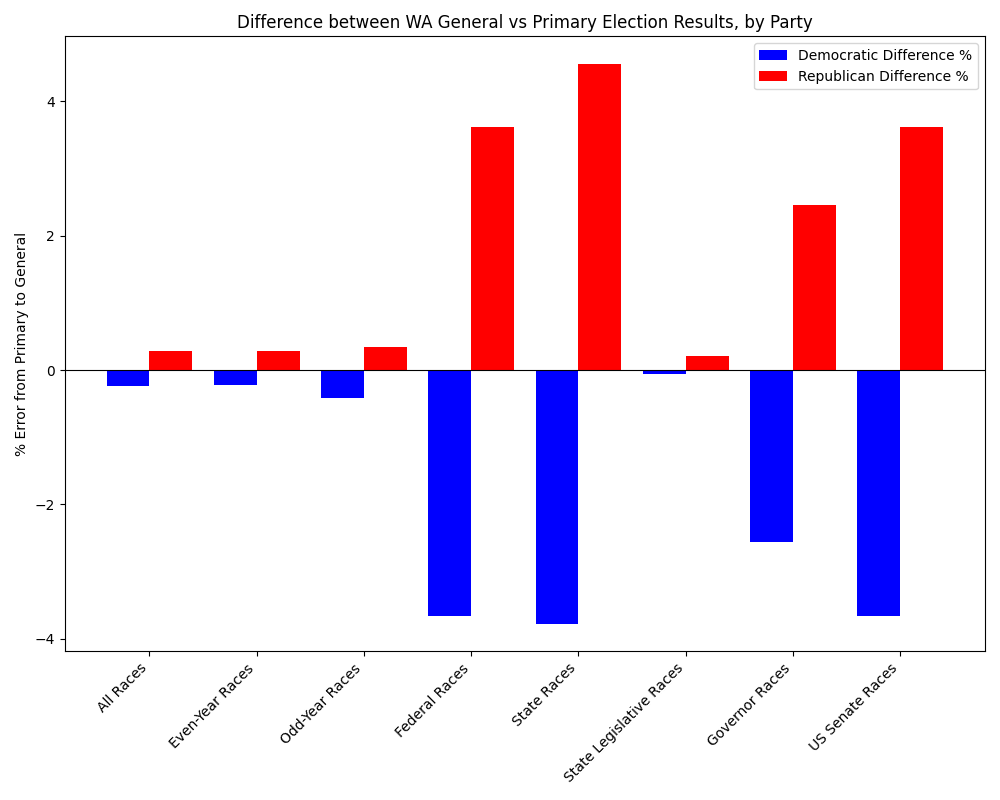
In the fog of a chaotic election year, Washington State’s Primary stands out as one of the clearest early signals for the nation. While the Evergreen State may not be highly representative of the United States as a whole—it’s bluer, whiter, and coastal—its Primary has historically proven to be a uniquely reliable predictor of general election outcomes. With voting already underway, all eyes should turn to the Northwest to gain clarity on the national political landscape.
Primary Importance and Predictive Power:
Washington’s unique Top-Two Primary system not only determines which candidates advance to the general election but also provides a remarkably accurate forecast of November’s results. Since 2012, Primary results have estimated general election outcomes with an average error of just 2%. However, in statewide and federal elections, Republicans tend to outperform their Primary results by about 4% in the general election.
The 2024 Primary introduces new legislative districts, with the most significant changes occurring in South Central Washington. These redrawn lines generally benefit people of color and Democrats, particularly in the 14th Legislative District (LD). This redistricting has created new opportunities for Democrats in traditionally Republican-held areas.
Key Races to Watch:
One of the most closely watched races will be in the 14th LD, which now encompasses East Yakima, the Lower Yakima Valley, Klickitat County, and East Pasco. This district has become 8% bluer, with most previous statewide Democrats winning in this new configuration. Democratic candidates Maria Beltran, Chelsea Dimas, and Ana Ruiz Kennedy are vying to flip this district blue for the first time in over a decade, although Democrat Patty Murray’s double-digit loss in this district suggests this won’t be easy.
 On the national stage, the 3rd Congressional District (CD) race is garnering significant attention. Democratic Congresswoman Marie Gluesenkamp Perez, who won by a narrow 1% margin in 2022, is defending her seat in a Trump-leaning district. She faces challenges from far-right Republican Joe Kent and “mainstream” Republican Leslie Lewallen. The primary results here will be crucial, with observers keen to see which party—if any—surpasses 50% of the vote and whether the Republican establishment-backed Lewallen can outperform the Trump-endorsed Kent.
On the national stage, the 3rd Congressional District (CD) race is garnering significant attention. Democratic Congresswoman Marie Gluesenkamp Perez, who won by a narrow 1% margin in 2022, is defending her seat in a Trump-leaning district. She faces challenges from far-right Republican Joe Kent and “mainstream” Republican Leslie Lewallen. The primary results here will be crucial, with observers keen to see which party—if any—surpasses 50% of the vote and whether the Republican establishment-backed Lewallen can outperform the Trump-endorsed Kent.
The 8th CD presents another swing district on the national radar. Incumbent Democratic Congresswoman Kim Schrier faces Republican Carmen Goers, who lags significantly in fundraising ($4.5M vs $166K). Interestingly, Schrier also faces a challenge from the left in Imraan Siddiqi, who’s running against Schrier’s pro-Israel stance. The key question here is whether Democrats can collectively surpass 50% of the vote.
The retirement of Democratic Congressman Derek Kilmer has opened up the 6th CD seat, setting the stage for a showdown between two prominent Democrats: Public Lands Commissioner Hilary Franz and State Senator Emily Randall. Both candidates boast similar liberal policies, strong fundraising, and high-profile endorsements, making for a close race. Republican Drew MacEwen is likely to secure the other spot in the general election unless Republican votes split unexpectedly.
In Seattle, a special election for the City Council seat vacated by Teresa Mosqueda pits corporate-friendly appointed-Councilmember Tanya Woo against progressive challenger Alexis Mercedes Rinck. We’re looking to see how the electorate changes in a high-turnout even-year Primary compared to the typical low-turnout, older, whiter odd-year city council elections.
The retirement of long-serving Republican Congresswoman Cathy McMorris Rodgers has opened up the 5th CD seat, drawing a crowded field of candidates. Leading Republicans include Spokane County Treasurer Michael Baumgartner and State Senator Jaquelín Maycumber, while Democrats Carmela Conroy and Dr. Bernadine Bank are vying for a potential upset in this traditionally Republican district.
Turnout Projections:
Turnout will be a critical factor in this Primary. The average turnout in August primaries of the last six presidential cycles is 42.72%, with a high of 54.44% in 2020 and a low of 34.88% in 2016. Current projections suggest turnout closer to the six-cycle average rather than the 2020 peak, but we’ll keep tracking turnout with our new Early Vote Dashboard.
 In conclusion, Washington State’s Primary election offers a unique opportunity to gauge the political temperature of the nation ahead of the general election. The combination of the state’s predictive Top-Two Primary system, recent redistricting, and several competitive races across various levels of government makes this an essential early indicator of both state and national trends. As we move closer to the general election, the results from Washington will provide crucial insights into voter preferences, party strengths, and potential shifts in the political landscape.
In conclusion, Washington State’s Primary election offers a unique opportunity to gauge the political temperature of the nation ahead of the general election. The combination of the state’s predictive Top-Two Primary system, recent redistricting, and several competitive races across various levels of government makes this an essential early indicator of both state and national trends. As we move closer to the general election, the results from Washington will provide crucial insights into voter preferences, party strengths, and potential shifts in the political landscape.
This guide is a project of the Washington Community Alliance Action Fund and our contributors. For those seeking more information and real-time election results, the Washington Community Alliance Data Hub is our data-driven resource hub providing accessible research and responsive technical assistance to promote high-participation elections.
—
Contributors:
Andrew Hong, Washington Community Alliance Action Fund
Kamau Chege, Washington Community Alliance Action Fund
Logan Camporeale, Campo Consulting



